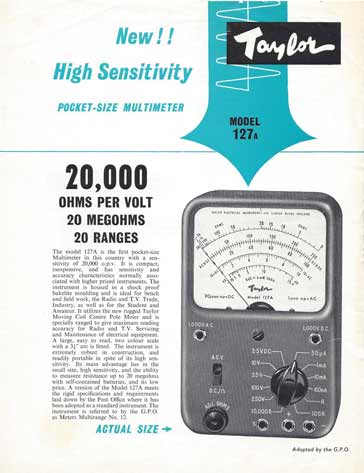Taylor 127A Vintage Analogue Multimeter
The Taylor 127A is a vintage analogue multimeter manufactured by Taylor Instruments of Slough, dating from the mid 1960s and capable of providing excellent service.
Vintage Test Equipment Includes:
Windsor 77A Multimeter
Taylor 127A Multimeter
The Taylor was an analogue multimeter introduced in the mid 1960s as a quality general purpose multimeter for a variety of applications.
Being relatively compact, yet combining accuracy and sensitivity, it was used by many service engineers, and it was advertised as being adopted by the GPO (What is now British Telecommunications)

As with many other Taylor multimeters, a leather case was also available and this enabled it to be well protected when used in a commercial service environment.
Taylor 127A summary & specification
The model 127A was a pocket sized multimeter that provided a sensitivity of 20 000Ω per volt. It was advertised as being compact, inexpensive and having the accuracy and sensitivity normally associated with higher price test instruments.
The multimeter is housed in a black bakelite moulding and it was aimed at being used for both bench and field work for the radio and TV trade, and general industry as well as for the student and radio amateur.
| Brief Specification for the Taylor 127A Vintage Analogue Multimeter |
|
|---|---|
| Parameter | Specification |
| DC Current | 50µA, 1mA, 10mA, 100mA & S* |
| DC Volts | 0.3, 2.5, 10, 25, 100, 250, 1 000, and 25kV using high voltage probe. |
| AC Volts | 10, 25, 100, 250, 1 000 |
| Resistance | 0-2 000Ω (20 Ω centre scale). 0-200kΩ (2 000 Ω centre scale). 0 - 20 MΩ (200 000Ω centre scale). |
| Output | 5 output ranges are obtainable via an external condenser. |
| Decibels | 5 decibel ranges |
| Accuracy | Within: ±3% of full scale deflection on DC ranges ±4% of full scale deflection on AC ranges |

One of the unique selling features for the Taylor 127A was the meter movement. It was described as a "new rugged Taylor Moving Coil Centre Pole Meter." This was arranged to give the maximum reading accuracy as it had a large 3¼ inch arc two colour scale.
A version of the multimeter was made to fulfil the specifications and requirements set down by the then GPO (now British Telecommunications) and it was referred to by them as the Meter Multirange No. 12.
Meter in use
The meter was very convenient and easy to use - mine was bought new in about 1967, complete with the leads and leather case.
The ranges were good, and enabled a good step through the sorts of voltage and current ranges that were needed. For very low current levels it was possible to utilise the "S" range which effectively just used the meter on its own - beware not to accidentally put an overload on it!.
The decibel range was very useful when measuring audio and other levels on the AC volts range.
One drawback of the meter was that it did not measure AC current, which many more expensive meters did. However, in view of the cost and the test meter and its other advantages, this was not a major issue. AC current was not a measurement that was needed that often.
Batteries
The meter required two batteries to be able to operate on the ohms ranges. They were defined with the type numbers used at the time: U10 and B121. Both are difficult to come by these days.
The U10 was a zinc carbon cell that measured 13/16 of an inch (20.6mm) in diameter and 2 5/16 inches (58.7mm) in height.
The B121 was a 15 V battery used for the high ohms range and the battery was initially designed for deaf aid use.
Both these batteries were also used in the AVO meters.
It is possible to buy modern alkaline U10 batteries online, and I found a replica B121 that used the external case of a B121 but internally used a series of LR1130 cells to get the right voltage.
Overall the Taylor 127A meter has been a delight to use, and I still have it and use it occasionally. It was been reliable and gives sufficiently accurate readings for most requirements.
Although it may not be as accurate as some of today's digital multimeters, how many of them will be working in 50 years time.
 Written by Ian Poole .
Written by Ian Poole .
Experienced electronics engineer and author.
More History:
Radio history timeline
History of the radio
Ham radio history
Coherer
Crystal radio
Magnetic detector
Spark transmitter
Morse telegraph
Valve / tube history
PN junction diode invention
Transistor
Integrated circuit
Quartz crystals
Classic radios
Mobile telecoms history
Vintage mobile phones
Return to History menu . . .



